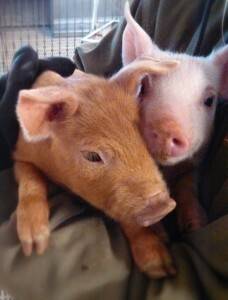There are so many subjects that I’d like to talk about today but I must go back to my favorite topic… pigs!
Admittedly, action by the Humane Society of the United States (HSUS) is forcing me to advocate today! This organization has purchased a full page insert scheduled to run tomorrow in USA Today, which is our nation’s largest newspaper by circulation. The objectives of the HSUS ad buy are:
is forcing me to advocate today! This organization has purchased a full page insert scheduled to run tomorrow in USA Today, which is our nation’s largest newspaper by circulation. The objectives of the HSUS ad buy are:
- To cause concern about the care of animals raised for food.
- To question animal confinement by describing it as a shift from family farms to industrial agribusiness.
- To insinuate that “factory farms” jeopardize the welfare of animals, damage public health and harm the environment.
HSUS is paying to spread lies about what I do, and I take that personally! The term “factory farms” is being used because of its negative connotation, and it’s certainly a term I dislike very much. Sure, the average farm size has increased over time due to economies of scale. Economies of scale is defined as the cost advantage that occurs when output is increased and variable costs are reduced from operational efficiencies and synergies.
Increased volume (or output) is simply a business concept exercised by a lot of other businesses and industries. Retail stores use size to be more efficient. Stores use technology to be better! Why is it so bad when farmers use proven business techniques?
As I have shared many times, I have raised pigs many different ways during the past 50 years. I have been a part of this fantastic transition! In the old days, I watched sows tear each other apart when they returned to a pen after nursing their pigs. I fought blizzards to feed and water my pigs, struggling to keep them from freezing to death. I have farrowed sows in that beautiful looking pasture only to find that the sow had her pigs in a mud hole, and baby pigs don’t have good odds of surviving in water and mud! Modern production practices have allowed us to remove many variables that led to injury and illness.
Recently I returned to a full-time job in the construction side of raising pigs. My job is to improve the buildings in which pigs are housed. Getting pigs raised inside has been a huge improvement, but we don’t stop there. One thing I’ve noticed by visiting hog barns across the Midwest is that the pigs’ welfare is always top of mind. There is zero tolerance for abuse, and signs are hung telling readers to call a listed number if they see ANY animal abuse. We have even gone to having our certification meetings for Pork Quality Assurance (PQA Plus Certification®) program every year instead of every three years!
There is a lot of research going on all the time to make these momma sows more comfortable and stress free. Animals grow better and have more babies when they are comfortable and less stressed! And, yes, more live pigs per liter can lead to increased profits for farmers. This is a win, win. That’s why it’s just unbelievable to me that we get attacked for doing what’s right!
Now keep in mind that HSUS is not actually thinking about animal welfare. After all, how do you think they can afford to run such ads? HSUS is very good at raising money. In fact, HSUS raises than $100 million annually but less than one half of one percent is spent to improve the life of animals. Most of the money raised goes toward the comfort and wealth of HSUS employees!
If you happen to see the big expensive HSUS ad, please remember that my fellow pig farmers and I are the ones with the welfare of our pigs in mind!
